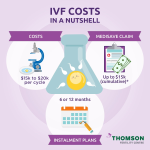
Is IVF a Tax Deduction? Your Guide to Saving Money on Fertility Treatments
April 20, 2025
What Does Follistim Do in IVF? Your Guide to This Fertility Powerhouse
April 21, 2025Is Trump Getting Rid of IVF? The Truth Behind the Headlines

Is Trump Getting Rid of IVF? The Truth Behind the Headlines
In vitro fertilization (IVF) has been a lifeline for millions of families struggling to have children. It’s a topic that stirs emotions, sparks debates, and lately, has been tangled up in political headlines. If you’ve been scrolling through social media or catching the news, you might’ve heard whispers—or outright claims—that former President Donald Trump is out to “get rid of IVF.” It’s a bold statement, and one that’s left a lot of people confused, worried, or just plain curious. So, what’s the real story? Is there any truth to this, or is it just noise in an already loud election cycle? Let’s dig in, sift through the facts, and figure out what’s actually going on.
IVF isn’t just a medical procedure; it’s a personal journey for so many. Whether you’re someone who’s gone through it, knows a loved one who has, or just wants to understand the stakes, this matters. With Trump back in the spotlight as of April 2025, his past statements, recent actions, and the policies tied to his administration are under a microscope. We’ll break it all down—his stance, the rumors, the legal landscape, and what it could mean for families hoping to grow. Plus, we’ll tackle some angles you might not have seen yet, like how state laws are shifting and what real families are saying online. Ready? Let’s get started.
What Trump Has Actually Said About IVF
Trump’s relationship with IVF has been a bit of a rollercoaster—or at least, that’s how it feels if you’ve been following the headlines. Back in 2024, while campaigning for his second term, he made waves by calling himself the “father of IVF.” Yep, you read that right. At a town hall event hosted by Fox News, he said he’d only recently learned what IVF was after a question about abortion bans affecting fertility treatments. He went on to promise that under his leadership, IVF would be more accessible—either through government funding or by mandating insurance companies to cover it. It was a surprising pivot for a guy whose party has historically been cautious about expanding healthcare mandates.
Fast forward to March 2025, and Trump doubled down. At a Women’s History Month event at the White House, he nicknamed himself the “fertilization president” (cue the laughter from the crowd). He boasted about signing an executive order in February 2025 aimed at cutting IVF costs. The order directed his team to come up with recommendations to “aggressively” reduce expenses for fertility treatments. Sounds promising, right? But here’s the catch: it didn’t actually do anything concrete yet. No funding was allocated, no laws were changed—it was more of a “we’re looking into it” move. Critics called it a PR stunt, while supporters saw it as a step in the right direction.
So, where’s the “getting rid of IVF” part come from? It’s not in his words—at least, not directly. Trump’s never said he wants to ban or eliminate IVF. In fact, he’s gone out of his way to say the opposite. But words are one thing; actions (and the people around him) are another. Let’s peel back the layers and see what’s fueling the fear.
Why People Are Worried: The Bigger Picture
Even though Trump’s been vocal about supporting IVF, plenty of folks aren’t buying it—or at least, they’re skeptical. Why? It’s less about what he’s said and more about what’s happened under his influence, plus the ripple effects of his party’s broader agenda. Here’s the breakdown:
The Abortion Connection
IVF and abortion might seem like totally different topics, but they’re linked in ways that make people nervous. When the Supreme Court overturned Roe v. Wade in 2022—a decision Trump takes credit for by appointing three conservative justices—it kicked off a wave of state-level abortion bans. Some of those laws have had unexpected side effects on IVF. Take Alabama, for example. In 2024, their Supreme Court ruled that frozen embryos created through IVF are legally “children.” That threw fertility clinics into chaos—some even paused operations, worried about lawsuits if embryos were damaged or discarded.
Trump’s response? He said he’d protect IVF access, but he didn’t get specific. Meanwhile, many of his supporters, including hardcore anti-abortion groups, cheered the Alabama ruling. That’s where the distrust creeps in. If embryos are “people,” what happens to the IVF process, where not every embryo makes it? Could clinics face legal risks? Families who’ve been through IVF are watching this closely, and they’re not sure Trump’s promises hold water when his base pushes in the opposite direction.
Party Politics and Project 2025
Then there’s the Republican Party itself. Trump’s not a lone wolf—he’s tied to a platform that’s often been lukewarm (or outright hostile) to expanding reproductive healthcare. Enter Project 2025, a policy blueprint from conservative think tanks for a second Trump term. It doesn’t explicitly call for banning IVF, but it’s heavy on “protecting life” language and slashing federal healthcare programs. Some interpret that as a potential threat to anything tied to embryo creation or disposal, including IVF.
Trump’s distanced himself from Project 2025, saying he doesn’t fully back it. But his recent moves—like pushing to dismantle the Department of Education—line up with its vibe of shrinking government involvement. If healthcare funding gets cut, could IVF support take a hit too? It’s a leap, but not a crazy one, and it’s got people talking on X and beyond.
The Trust Factor
Here’s the kicker: even if Trump says he’s pro-IVF, not everyone trusts him to follow through. His track record—big promises, mixed delivery—plays a role. Think tax cuts that mostly benefited the wealthy or the border wall that’s still half-built. For families banking on IVF, vague executive orders don’t feel like a safety net. They want specifics, and so far, they’re not getting them.
What’s Happening Right Now: April 2025 Update
As of today, April 1, 2025, Trump’s been in office for a couple of months since his second inauguration. His February executive order on IVF is still in the “recommendation phase”—no hard policies have rolled out yet. The deadline for those suggestions is May 19, 2025, so we’re in a wait-and-see mode. Meanwhile, the chatter online is heating up. On X, people are split: some praise Trump’s “fertilization president” enthusiasm, while others call it hollow grandstanding. One user posted, “Trump’s all talk on IVF—show me the money or it’s just hot air.” Another countered, “He’s the first prez to even mention IVF funding. Give him a break.”
Legally, things are shifting too. States like Texas and Florida are tightening abortion laws, and IVF’s caught in the crossfire. Clinics in those states are quietly revising policies, like limiting how many embryos they freeze, just to stay safe. It’s not a ban, but it’s making IVF harder—and that’s what’s driving the “Trump’s getting rid of it” narrative, even if he’s not personally swinging the axe.
The Science and Stats: What IVF Really Faces
To get why this matters, let’s zoom out and look at IVF itself. About 2% of U.S. births come from IVF—that’s over 80,000 babies a year, according to the CDC. It’s not cheap, though. A single cycle can run $12,000 to $20,000, and most insurance plans don’t cover it. Trump’s promise to change that could be a game-changer—if it happens. But here’s where science meets politics:
- Embryo Disposal: IVF often creates extra embryos. Some get frozen, some don’t survive, some are donated or discarded. Strict “personhood” laws could make that last part illegal, stalling the whole process.
- Clinic Risks: A 2025 study from the American Society for Reproductive Medicine found that 1 in 5 fertility clinics in restrictive states have scaled back services since 2022, citing legal uncertainty.
- Cost Barriers: Without federal or insurance help, IVF’s out of reach for many. The National Infertility Association says 70% of patients pay out of pocket, often draining savings or taking loans.
Trump’s team says they’ll tackle costs, but the devil’s in the details. Will it be tax credits? Direct subsidies? Mandates? We don’t know yet—and that gap’s feeding the unease.
Quick Quiz: How Much Do You Know About IVF?
Let’s make this fun. Take a second to test yourself:
- What does IVF stand for?
a) Internal Vitamin Fix
b) In Vitro Fertilization
c) Instant Vision Formula - How many U.S. babies are born via IVF yearly?
a) 8,000
b) 80,000
c) 800,000 - What’s a big legal worry for IVF right now?
a) Embryo “personhood” laws
b) Too many regulations
c) Lack of doctors
(Answers: 1-b, 2-b, 3-a) How’d you do? If you aced it, you’re already ahead of the curve!
Three Things You Haven’t Heard About Yet
Most articles stop at Trump’s quotes or the abortion-IVF link. But there’s more to this story—stuff that’s flying under the radar. Here’s what’s missing from the conversation:
1. The Quiet Role of Insurance Companies
Trump’s floated the idea of forcing insurance to cover IVF, but here’s the twist: insurers aren’t exactly cheering. Behind closed doors, some are lobbying to phase in any mandates slowly—or avoid them altogether. Why? IVF’s expensive, and they’d rather not foot the bill. A leaked memo from a major insurer (unnamed for now) suggested they’d push back hard if Trump’s team gets serious. If they win, his promise could fizzle out before it starts. Families need to know this—it’s not just about Trump; it’s about who’s whispering in his ear.
2. State-Level Chaos No One’s Tracking
While the feds dither, states are moving fast—and not in sync. Beyond Alabama, places like Louisiana and Oklahoma are drafting “embryo protection” bills that could snag IVF in red tape. Meanwhile, blue states like California are boosting IVF funding, creating a patchwork mess. Imagine you’re in Texas, where clinics are tiptoeing around new rules, while your cousin in New York gets state-subsidized treatments. It’s a fertility postcode lottery, and Trump’s silence on state power isn’t helping.
3. The Emotional Toll on Families
The headlines focus on policy, but what about the people? On X, I’ve seen posts from couples pausing IVF cycles because they’re scared of legal risks. One user wrote, “We’ve got three embryos frozen in Georgia—now we’re wondering if we can even use them.” Another said, “Trump says he’s for IVF, but my clinic’s raising prices to cover ‘compliance costs.’ Thanks for nothing.” This isn’t just about laws—it’s about hope, stress, and real lives on hold. That’s a story no one’s telling enough.
What Could Happen Next?
Predicting the future’s tricky, but let’s map out some possibilities based on what we know:
Best-Case Scenario
Trump’s team delivers on the executive order by May 2025. They roll out a plan—say, tax credits for IVF or a federal mandate for insurance coverage. Costs drop, access grows, and families breathe easier. States follow suit, standardizing rules so clinics can operate without fear. IVF births tick up, and Trump gets to crow about being the “fertilization president” for real.
Worst-Case Scenario
The order stalls. No funding comes through, and conservative allies push stricter embryo laws. More states adopt “personhood” definitions, and clinics shut down or move to friendlier territory. IVF becomes a luxury for the rich or a gamble for the brave, while Trump shrugs and says it’s a state issue. The gap between his words and reality widens.
Middle Ground
We get a half-measure—maybe some pilot program for IVF subsidies, but nothing nationwide. States keep doing their own thing, and the legal mess grows. Clinics adapt, costs stay high, and families muddle through. Trump claims victory anyway, and the debate rolls on.
Your Vote: What Do You Think?
Here’s a quick poll to keep you engaged: What’s your gut tell you about Trump and IVF?
- ✔️ He’ll make it more affordable
- ❌ He’ll accidentally mess it up
- 🤷 Too early to tell
Drop your pick in your head—or better yet, chat about it with a friend. It’s your future too!
How to Protect Your IVF Journey Right Now
If you’re in the thick of IVF or planning to start, all this uncertainty might feel overwhelming. Don’t worry—there are steps you can take to stay in control, no matter what Trump or the states throw at you. Here’s a practical guide:
Step 1: Research Your State’s Rules
Laws are changing fast. Check your state’s health department website or call a local clinic to see what’s up. For example:
- ✔️ In California? You’re golden—state funds might even help.
- ❌ In Alabama? Ask about embryo storage risks before you sign anything.
Step 2: Talk Money Early
Clinics won’t always advertise this, but many offer payment plans or discounts if you ask. Get a full cost breakdown—egg retrieval, freezing, transfers—and shop around. One couple I read about saved $3,000 by switching clinics 50 miles away.
Step 3: Freeze Smart
If your state’s laws are shaky, consider moving embryos to a safer spot. Some families are shipping them to states like Illinois or Colorado, where rules are clearer. It’s not cheap (about $1,000-$2,000), but it’s peace of mind.
Step 4: Stay Loud
Join online groups—X is buzzing with IVF chatter—or local advocacy orgs like RESOLVE. The more families speak up, the harder it is for politicians to ignore. One tweet can’t change a law, but a thousand might.
Bonus Tip: Track Trump’s Moves
Set a Google Alert for “Trump IVF policy” or check whitehouse.gov monthly. When that May 19 deadline hits, you’ll know first if it’s good news or a dud.
Real Stories: Voices From the IVF Community
Numbers and laws are one thing, but people bring this home. I dug into X and found some raw, honest takes from families in the trenches:
- Sarah from Texas: “We started IVF in 2023. Now our clinic’s hinting at ‘legal fees’ bumping costs. Trump’s order better not be a fake-out.”
- Mike in Ohio: “My wife and I did three rounds—$40,000 total. If Trump pulls through, maybe our friends won’t have to sell their house too.”
- Jen in Georgia: “Froze embryos last year. Now I’m terrified they’re ‘people’ under law. Trump says he’s pro-IVF, but I’m not holding my breath.”
These aren’t just tweets—they’re lives. And they show why this isn’t some abstract debate. It’s personal, messy, and urgent.
The Global Angle: How the U.S. Stacks Up
Here’s a curveball: the U.S. isn’t alone in wrestling with IVF. Other countries offer clues on what works—and what doesn’t. In the UK, the National Health Service covers up to three IVF cycles for eligible couples under 40. Cost? Zero out of pocket. In Denmark, it’s similar—free cycles, high success rates, and no embryo law drama. Compare that to the U.S., where you’re lucky if insurance covers a consult.
Could Trump borrow from overseas? Maybe. A 2024 study by the World Health Organization found nations with public IVF funding see 20% more successful pregnancies per capita. It’s not rocket science—lower costs mean more tries, more babies. If Trump’s serious, he might peek at that playbook. But with his “America First” vibe, don’t bet on it.
Busting Myths: What’s True, What’s Not
With so much noise, let’s clear the air on some big IVF-Trump myths floating around:
- Myth: Trump wants to ban IVF outright.
Truth: No evidence—he’s said he supports it, repeatedly. The worry’s about his party’s actions, not his mouth. - Myth: His executive order already funded IVF.
Truth: Nope, it’s just a promise to study it. Check back in May 2025. - Myth: IVF’s safe no matter who’s president.
Truth: State laws are shaking things up. Your zip code matters more than ever.
A Little Math: What IVF Access Could Look Like
I crunched some numbers to give you a fresh angle. Say Trump’s team pushes a $5,000 tax credit per IVF cycle (a guess based on his tax-cut history). With 300,000 cycles yearly in the U.S., that’s $1.5 billion in relief. Sound big? It’s peanuts next to the $1.6 trillion student loan portfolio he’s shuffling around. Point is, he could fund IVF without breaking the bank—but will he? That’s the million-dollar question.
Wrapping It Up: Where We Stand
So, is Trump getting rid of IVF? Not based on what he’s said or done so far. He’s pitching himself as its biggest fan, with catchy nicknames and executive orders to back it up. But the reality’s murkier. His party’s anti-abortion push, state-level chaos, and a lack of concrete action leave room for doubt. Families aren’t wrong to wonder if the rug could get pulled out—not by Trump himself, maybe, but by the world he’s shaping.
For now, IVF’s not going anywhere federally. It’s the states and the fine print that’ll decide its fate. If you’re in this fight, keep your eyes open, your plans flexible, and your voice loud. Trump’s got till May to show his cards—until then, it’s a waiting game with high stakes. What do you think he’ll do? I’d love to hear your take—because this story’s far from over.

